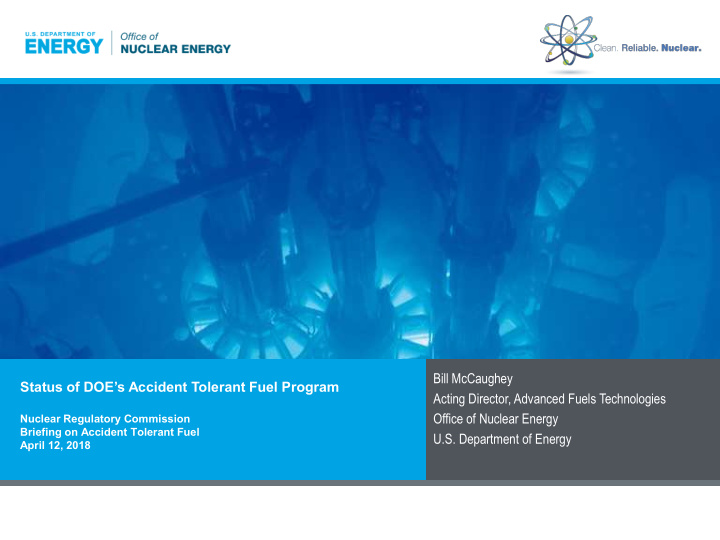



Bill McCaughey Status of DOE’s Accident Tolerant Fuel Program Acting Director, Advanced Fuels Technologies Office of Nuclear Energy Nuclear Regulatory Commission Briefing on Accident Tolerant Fuel U.S. Department of Energy April 12, 2018
Outline • Congressional Direction and Development Plan • National Laboratory R&D Support • NRC Cooperation 2 nuclear.energy.gov
Congressional Direction and Development Plan Following the accident at Fukushima, Congress directed the Department to start developing fuel with enhanced accident tolerance that can be used in existing light water reactors. The Development Plan: • Defines the general attributes of accident tolerant fuel. • Lays out an aggressive 10-year schedule starting in 2012. • Establishes the goal of inserting a lead fuel assembly or lead fuel rod in an operating commercial light water reactor by 2022. 3 nuclear.energy.gov
Development Plan • Phase 1: Feasibility Assessment and Down-Selection – FY 2012-2016 – Collaborative partnership between DOE, industry, and universities • Phase 2: Development and Qualification – FY 2017-2022 – Industry led efforts supported by DOE national infrastructure and universities • Phase 3: Commercialization – FY 2022 and beyond – Industry commercial activity deploying ATF into existing and future reactor systems 4 nuclear.energy.gov
Development Plan Being Updated 1. Revise the end state of Phase 2 (Development and Qualification) to include more than one set of lead fuel assemblies/lead fuel rods at one reactor. 2. Update and provide more details on the activities that make up Phase 2. 3. Describe Phase 3 activities (Commercialization). 4. Identify roles and responsibilities across multiple organizations, DOE, fuel vendors, utilities, EPRI, NEI, and the NRC. 5 nuclear.energy.gov
Industry Led Development of ATF Concepts in Phase 2 • Framatome • General Electric • Westinghouse - Chrome coated - Iron-chrome-aluminum - Silicon carbide cladding zirconium cladding cladding (FeCrAl) - Uranium silicide fuel - Doped uranium dioxide - Conventional uranium fuel dioxide fuel 6 nuclear.energy.gov
National Laboratory R&D Support to Industry and NRC • Irradiation Testing – Advanced Test Reactor at Idaho National Laboratory – High Flux Isotope Reactor at Oak Ridge National Laboratory – Halden test reactor in Norway • Post Irradiation Examination – Baseline and advanced PIE • Safety Testing – Integral LOCA test facility at Oak Ridge National Laboratory – Transient Reactor Test (TREAT) Facility at INL • Advanced Modeling and Simulation – Nuclear Energy Advanced Modeling and Simulation (NEAMS) Program – Consortium for Advanced Simulation of Light Water Reactors (CASL) 7 nuclear.energy.gov
NRC Cooperation • Fuel vendor teams began licensing discussions at the start of Phase 2. • Information exchanges between NRC staff and laboratory subject matter experts increased in Phase 2. • Cooperation was formalized in an addendum to the memorandum of understanding between NRC and DOE. – Obtain information from DOE necessary to prepare for licensing accident tolerant fuel concepts. – Ensure that the program’s research focus areas address key safety issues associated with the licensing of accident tolerant fuel. 8 nuclear.energy.gov
Summary • Phase 1, Feasibility Assessment and Down-Selection, is complete. • Phase 2, Development and Qualification, was expanded and accelerated to support industry. • National laboratories are supporting the industry teams and the NRC in irradiation testing, post irradiation examination, safety testing, and advanced modeling and simulation. • NRC cooperation increased in Phase 2 and became more focused on the most promising accident tolerant fuel concepts. 9 nuclear.energy.gov
10 nuclear.energy.gov
Recommend
More recommend